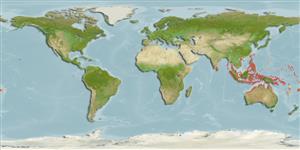>
Ovalentaria/misc (Various families in series Ovalentaria) >
Ambassidae (Asiatic glassfishes)
Etymology: Ambassis: Derived from Greek, anabasis = climbing up (Ref. 45335).
More on author: Günther.
Environment: milieu / climate zone / depth range / distribution range
Ecologia
marino; acqua dolce; salmastro demersale; amfidromo (Ref. 51243); distribuzione batimetrica 0 - 2 m (Ref. 86942). Tropical; 26°N - 27°S, 75°E - 172°W
Indo-Pacific: Arabian Sea and India, to Indonesia, Malaysia, East Timor, Taiwan, southern Japan, northern Australia, New Guinea, New Caledonia, Fiji, Samoa and the Cook Is.
Size / Peso / Age
Maturity: Lm ? range ? - ? cm
Max length : 10.3 cm TL maschio/sesso non determinato; (Ref. 7050)
Spine dorsali (totale): 8; Raggi dorsali molli (totale): 9-10; Spine anali 3; Raggi anali molli: 9 - 10. Resembles A. urotaenia, but differs in having large eye, and a gently-rounded snout. Eye diameter over 30% and interorbital width over 20% of head length. Cheek scales in 2 rows. Attains 8 cm TL.
Inhabits clear, flowing creeks, usually within 20 kilometers of the sea (Ref. 44894). Commonly found in brackish waters and river mouths. Occurs near mangroves, stagnant and running freshwater (Ref. 7300) and coastal areas (Ref. 45255). This species has a marine larval stage, judging from its broad distribution. One of the best viewing areas is at the Freshwater creek picnic ground in Cairns, where individuals frequently aggregate along the vegetated stream margin (Ref. 44894).
Life cycle and mating behavior
Maturità | Riproduzione | Deposizione | Uova | Fecundity | Larve
Paxton, J.R., D.F. Hoese, G.R. Allen and J.E. Hanley, 1989. Pisces. Petromyzontidae to Carangidae. Zoological Catalogue of Australia, Vol. 7. Australian Government Publishing Service, Canberra, 665 p. (Ref. 7300)
IUCN Red List Status (Ref. 130435)
Threat to humans
Harmless
Human uses
Informazioni ulteriori
Nomi ComuniSinonimiMetabolismoPredatoriEcotossicologiaRiproduzioneMaturitàDeposizioneSpawning aggregationFecundityUovaEgg development
BibliografiaAcquacolturaProfilo di acquacolturaVarietàGeneticaElectrophoresesEreditarietàMalattieElaborazioneNutrientsMass conversion
CollaboratoriImmaginiStamps, Coins Misc.SuoniCiguateraVelocitàModalità di nuotoArea branchialeOtolithsCervelliVista
Strumenti
Special reports
Download XML
Fonti Internet
Estimates based on models
Preferred temperature (Ref.
123201): 26.2 - 29.3, mean 28.7 °C (based on 1629 cells).
Phylogenetic diversity index (Ref.
82804): PD
50 = 0.5000 [Uniqueness, from 0.5 = low to 2.0 = high].
Bayesian length-weight: a=0.01230 (0.00515 - 0.02940), b=3.01 (2.82 - 3.20), in cm total length, based on LWR estimates for this Genus-body shape (Ref.
93245).
Trophic level (Ref.
69278): 3.5 ±0.41 se; based on food items.
Resilienza (Ref.
120179): Alto, tempo minimo di raddoppiamento della popolazione meno di 15 mesi (Assuming Fec > 10,000).
Fishing Vulnerability (Ref.
59153): Low vulnerability (10 of 100).
